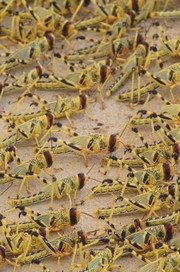Locust swarms threaten turbulent border region, experts on close watch

Heavy seasonal rains and lack of security in the region are constraining survey and control efforts, according to agriculture experts in Chad.
In its latest bulletin FAO said a small swarm of the crop-destroying insects formed last month in Chad and there are several unconfirmed reports of other swarms.
“There is a chance that a few swarms will form in September and October along the Chad/Sudan border and some of these could move towards Northwest Africa,” the report added. “Low numbers of small adult groups and swarms are likely to form in Darfur.”
Many arid Sahel countries are still reeling from last year’s devastating locust invasions – the worst seen in the region for 15 years – that destroyed millions of hectares of crops and pasture in Mali, Mauritania, Niger and northern Senegal.
The locust invasions also coincided with drought, which in Niger alone prompted a US $57.6 million appeal to provide 2.5 million hungry people with emergency food aid.
In July FAO said the region would likely be spared a repeat of 2004’s damage. Still, it said, there remained pockets of activity that could be cause for concern.
“The situation [in Chad today] is serious enough to maintain very intense surveillance operations,” Keith Cressman, a locust forecasting officer at FAO headquarters in Rome, told IRIN on Tuesday. “We don’t want to be caught with any surprises.”
He said some local residents have said they’ve spotted swarms, but the FAO consultants on the ground have yet to confirm the reports in this sparsely populated corner of the Sahara desert.
With good rains this season conditions are highly conducive to breeding, and bands of hoppers – juvenile and highly mobile locusts – are present, according to FAO.
“These are the correct ingredients for [a situation] that could develop into something serious,” Cressman said.
Rains continue to impede road travel in the region, where normally dry riverbeds regularly fill up with water and completely block main routes for days at a time. An FAO helicopter, sent to Chad in August, is being used for surveillance operations.
FAO cautioned in its bulletin, dated 1 September, that only once the rains end and vegetation starts to dry up that the extent of any locusts swarms will be known.
An agricultural expert based in the Chadian capital, N’djamena, said problems of insecurity near the Sudan border are also limiting experts’ ability to inspect the area.
“We have heard there were locusts near the border,” said an official with Chad’s Ministry of Agriculture who declined to be named. “But because of insecurity we have not been able to go there.”
In western Sudan rebels have been fighting the government and its militia since 2003 and violence and banditry are common across the border area.
An adult desert locust can consume roughly its own weight – about two grams – in fresh food every day. A small portion of an average swarm can eat the same amount of food in a day as about 2,500 people.
